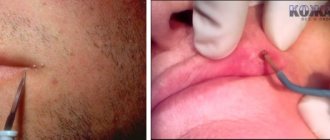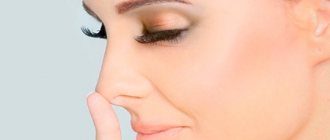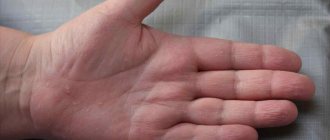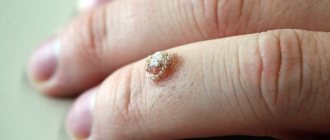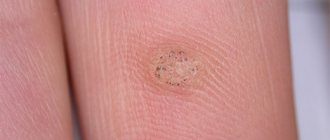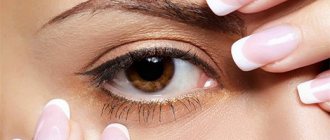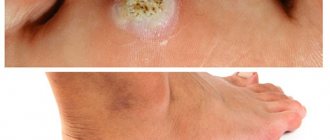A subungual wart is a benign formation on the skin caused by the human papillomavirus. Location: area of the nail plates of the fingers and toes.
Such neoplasms do not cause itching or pain, but tend to grow. Therefore, gradually warts under the fingernails begin to spoil the appearance of the fingers and cause psychological discomfort. In addition to aesthetic problems, severely enlarged warts on the feet can be injured when wearing shoes, which causes pain and leads to infection.
As these tumors grow, they destroy the nail plate and nail matrix, leading to irreversible processes in the tissues.
Causes
The appearance of warts under the fingernails and toenails is caused by the activity of the human papillomavirus. Once in the body, it can remain in it for a long time without causing clinical signs. Activation of the virus occurs when resistance decreases as a result of severe or prolonged stress, insufficient supply of nutrients, as well as after illnesses and injuries.
A favorable factor for the growth of subungual and periungual warts on the feet is tight shoes that squeeze the toes or rub the skin in one place.
Diseases that cause growths under the nails
After infection with the papilloma virus, a small benign formation with a smooth or rough surface may appear on the surface of the skin. Its size may not increase for a long time, since human immune cells inhibit the proliferation of pathogenic microorganisms. However, some diseases reduce the body's resistance and provoke the growth of tumors:
- hyperhidrosis of the palms and feet;
- pathologies of the internal secretion organs, leading to hormonal disorders;
- autoimmune diseases;
- leukopenia, HIV, chronic hepatitis C and B;
- allergic reactions.
The accelerated growth of a periungual or subungual wart can be caused by a violation of its integrity as a result of injury, as well as illiterate exposure to physical, chemical or thermal means for the purpose of removal.
Onychophagy contributes to the spread and growth of viral warts under the nails. This is the name of a disease in which a person has a constant desire to bite his nails and the skin around them.
Treatment with pharmaceutical drugs
Traditional medicine offers several treatments for periungual warts. They are usually divided into two groups - conservative treatment and surgical intervention.
Conservative therapy refers to the prescription of medications that fight HPV and help improve immunity.
Usually these are medications for oral administration. The most effective of them:
- Cycloferon
- Anaferon
- Isoprinosine
You should not take these medications for self-medication. Only a specialist can prescribe them based on the clinical picture of the disease. In some cases, dermatologists recommend topical treatment.
Products for external use are prescribed depending on how many warts appear, what their size is and where they are located.
The list of the most effective medications for external use includes:
- Imiquimod (from RUB 2,019) is an immunomodulator.
- Solcoderm (price varies from 401 to 1,489 rubles)
- Verrukacid (from 211 rubles) - acid-based medications that promote tissue necrosis.
- Viferon (from 123 rubles) - antiviral ointment.
- Cryopharma (from RUB 859) is a refrigerant that freezes warts.
- Salicylic acid (price from 6 rub.)
- Collomak (cost ranges from 264 to 490 rubles) - keratolytic agents that destroy the stratum corneum of papilloma.
The doctor prescribes all of the above medications for the treatment of small periungual warts that are located on the surface of the skin.
If the papilloma is large, has a deep root or is an old formation, then it is recommended to resort to surgery.
How does the disease manifest itself?
A wart under the nail or near the nail plate looks like a nodular or spherical growth with a rough surface of a flesh-colored, light pink or grayish color. When several warts merge, a tubercle is formed, which has an unsightly appearance due to the presence of cracks, grooves and protrusions on its surface.
Clinicians separately identify subcutaneous condylomas, which are warts whose roots are located deep under the nail plate. Due to this localization, this form of subungual formations causes pain during growth and leads to nail detachment.
Types of warts
Upon examination, the dermatologist differentiates several types of subungual neoplasms, taking into account their shape, location of formation, surface condition and other signs.
- Vulgar warts are round formations that have a rough surface. Their characteristic feature is crowded arrangement.
- Flat ones have a smooth shiny surface that protrudes slightly above the surface of the skin. When diagnosing, the irregularity of the shape and the absence of excessive keratinization are taken into account.
- Plantar warts (spikes) are localized on the dorsum of the foot, but in some cases they can form near the nail plates. These keratinized formations practically do not protrude above the surface, but grow deep into the skin, causing significant pain when walking or pressing.
- Periungual or nail warts are a type of vulgar formation, and differ only in their specific localization.
Diagnosis and symptoms of periungual warts
If warts have formed near the nail plate or under it, then they can very easily be confused with the characteristic features of other diseases.
Therefore, it is recommended to consult a dermatologist who can correctly diagnose the tumor and prescribe appropriate treatment to eliminate papilloma.
Self-medication in this case can lead to negative results. A competent specialist, after examining the skin and neoplasms on it, will quickly make a diagnosis.
Occasionally, doctors prescribe additional tests to eliminate the risk of developing cancer.
Periungual warts look very much like calluses.
However, the main difference between a callus and a papilloma is that the skin pattern is preserved on the surface of the former and thrombosed capillaries are not visible in its structure.
But on the surface of the papules black specks are clearly visible. This is easy to notice even with a visual inspection.
When a wart forms under the nail plate, gradual destruction of the nail occurs, and this is very similar in appearance to a fungal infection.
If we compare the photos presented in many literary medical sources, the pathologies are completely indistinguishable in appearance.
In this case, it is necessary to sow mushrooms. If the patient has HPV, it will test negative.
If necessary, the dermatologist may additionally recommend undergoing: Dermatoscopy.
During the procedure, a dermoscope device is used, which displays the surface of the formation at tenfold magnification. Structure, symmetry and contours become more clearly visible.
Biopsy. In this case, tiny parts of the skin nodule are taken for examination under a microscope.
Methods of transmission of warts and how to protect yourself from infection
The papillomavirus, which causes the formation of subungual skin growths, most often enters the body through microcracks in the skin through tactile contact and even a simple handshake with a sick person or virus carrier. The presence of cuts, abrasions, hangnails and other injuries on the palms and feet significantly increases the risk of infection.
Subungual warts can be transmitted through personal hygiene items, as well as equipment in public baths. There is a high probability of infection in swimming pools, water parks and similar places with high humidity.
The risk of developing pathology is very high when visiting a nail salon where workers do not pay enough attention to sterilizing instruments. Transmission of the virus can also occur in childcare settings when children wear someone else's shoes or clothes.
You can minimize the risk of infection by following these rules:
- exclude tactile contact with a person who has warts on their hands;
- check the availability and use of instrument sterilizer in beauty salons;
- when trying on shoes in a store, use only your own socks or new socks offered by the seller;
- wear special shoes in swimming pools and baths;
- wash your hands thoroughly after visiting public institutions or public transport;
- avoid wearing uncomfortable and tight shoes;
- do not bite your nails;
- prevent the formation of burrs and cracks on the skin of the fingers, palms and feet.
It is very important to maintain personal hygiene every day, take a shower on time, and regularly change socks and tights. If your shoes are wet, do not wear them until they are completely dry.
How to prevent the occurrence
First of all, you need to have your own hygiene products, and you also need to use individual towels. You should not wear someone else's gloves, mittens, or shoes that are not your own. To prevent infection, you need to take care of the skin of your hands, in particular near the nails. After all, even a damaged cuticle can facilitate the penetration of the virus into the human body.
The risk of such growths near the nails can be reduced by maintaining personal hygiene, timely changing socks, and using individual shoes in swimming pools and shared showers.
How to diagnose and treat the disease
For an experienced dermatologist, it is not difficult to correctly diagnose warts under the nails. The main task is to exclude malignant tumors.
To make an accurate diagnosis, the following methods are used:
- examination of subungual neoplasms and assessment of the condition of adjacent skin;
- histological examination (if a malignant tumor is suspected);
- papillomavirus typing (if there are many different tumors on the body).
The most effective treatment method is to remove the wart with a laser beam. But there are other ways to get rid of these growths, both in clinics and with the help of medications or folk recipes at home.
Diagnostics
A subungual wart can easily be confused with other diseases of the skin and nails, for example, calluses. Therefore, you should not diagnose yourself, but rather seek professional help. Although an experienced doctor can determine the disease even during examination.
Subungual growths can also be easily confused with fungal diseases. Therefore, in some cases, in addition to examination, it is necessary to do a fungal culture to clarify the diagnosis. A biopsy or dermatoscopy may also be prescribed.
Today, treatment of subungual warts is carried out conservatively or surgically.
How to remove periungual growths in medical institutions
To treat a subungual wart, it is worth visiting a dermatologist, who will rule out the malignant nature of the tumor and select the optimal method for its removal.
You can get rid of a wart on a toenail or fingernail in a medical facility in the following ways:
- cryodestruction;
- laser destruction;
- electrocoagulation;
- surgical intervention.
The first three methods require specialized equipment, but the last method is the most traumatic and painful.
Sometimes a chemical method is used to burn out subungual warts with concentrated acids or alkalis. But they resort to it extremely rarely, since it requires certain skills and maximum accuracy from the specialist. In addition, these substances are precursors, which require special permission to work with.
Hardware methods
All hardware methods for removing subungual warts have their advantages and disadvantages. Not every clinic has the necessary expensive equipment to carry them out.
Removing papillomas using a laser beam is recognized as the best method. It eliminates bleeding, takes a few minutes, and leaves no scars. Laser destruction also minimizes relapses. The only disadvantages include the high cost compared to other methods.
The electrocoagulation method involves removing subungual warts using an applicator through which a current of a certain frequency is passed. As a result, damaged blood vessels are cauterized, which reduces the risk of wound infection and explains the absence of bleeding.
Radical methods
Surgical excision of warts involves cutting off the growth with a scalpel under local anesthesia. Dermatologists resort to this method when the subungual tumor grows significantly, as well as when its roots go deep under the nail plate.
The disadvantages of the method include a high percentage of the likelihood of relapse, a long healing period, and the presence of postoperative scars.
Cryotherapy
It involves cauterizing the wart with liquid nitrogen. Its advantage is the simplicity of the procedure, the absence of the need to use specialized equipment and anesthesia, as well as excellent results. Disadvantages - if the tumor grows significantly, repeated manipulation is required. Contraindications to cryotherapy include the period of gestation and disturbances in the functioning of the endocrine glands.
Chemical method
Trichloroacetic acid and concentrated nitric acid are used to remove growths chemically.
The complexity of the method lies in the fact that these chemical compounds must be applied exactly to the affected area, since contact with healthy tissue causes severe burns, and after healing, the formation of scars.
What are warts
Warts are skin growths of a viral nature, formed as a result of the proliferation of epidermal cells. In most cases, they do not cause any discomfort and are a purely aesthetic defect. They are not prone to degeneration into malignant tumors.
Without treatment, warts can persist for years, although they often resolve and disappear on their own.
Medicinal methods of combating growths on nails
If the affected tissue grows slightly, dermatologists suggest using special ointments to treat warts. These include the following groups of pharmacological drugs:
- keratolytics (Superchistotel, Ferezol), which are based on salicylic and lactic acids, which dissolve the affected layers of the skin;
- drugs that cause necrosis of the affected areas of the skin and their subsequent mummification (Solcoderm, Condyline).
If you decide to use these drugs, you must strictly follow the instructions supplied with them and avoid contact with intact areas of the skin.
Separately, it is worth highlighting the wart remedies developed by Wartner, which can be used at home. These include:
- Varner applicator pen filled with gel containing trichloroacetic acid;
- Warner Cryo in the form of an aerosol based on dimethyl ether and propane.
Sometimes, during complex therapy, it is advisable to use other means - creams containing antiviral components that prevent the virus from being absorbed into the bloodstream and spreading it to healthy areas of the body. Among them are 3% Florenal and Oxolinic 2% ointment.
Treatment of periungual warts at home
You can get rid of periungual warts yourself. Since ancient times, folk healers have recommended a large number of ways to solve this problem almost painlessly.
However, here you need to be patient and carefully follow the recipe.
Periungual warts are lubricated with juice squeezed from the stems of celandine. Thyme, onion, euphorbia and juice from ripened rowan berries are also used.
Castor oil and finely grated horseradish mixed with salt have long been used to treat warts.
Wild parsley, purslane and wild apples are also popular because these plant solutions are highly acidic.
You can lubricate the skin tumors that appear with the juice of castor beans and grapevines. A more gentle, but no less effective effect is provided by rubbing with rose petals, rosehip tincture or juice of the hairy hawkweed.
Among the aggressive agents, acetic acid is isolated, which is applied daily to the periungual wart when treated at home.
When using these folk recipes, it was noted that the surface of the papilloma began to turn black. This indicates the death of the tissues of the formation.
At this time, it is not recommended to cut off the wart; it is better to wait until it falls off on its own. If you do not adhere to this rule, you can provoke a relapse.
What folk remedies can be used
Proven folk methods of getting rid of warts include:
- celandine juice, squeezed directly from the plant onto the growth or purchased ready-made at the pharmacy;
- gruel of 9% vinegar and flour;
- mashed calendula leaf applied to the papilloma overnight;
- castor oil applied to the damaged area 2 to 3 times a day.
Before lubricating subungual formations with such agents, you should understand that growths can be cured only in the absence of an inflammatory reaction and pain.
If, in search of a remedy to get rid of papillomas, you have chosen a folk recipe, you need to lubricate them for 7-10 days. If the treatment does not have any effect, then you should consult a dermatologist for help.
"Verrukatsid" - instructions for use
One of the most effective drugs in the fight against viral growths is considered to be “Verrucacid”. It contains several components: water, alcohol and two active ingredients: meta-cresol and phenol.
This is an oily liquid that works well on warts, condylomas and calluses. However, the drug should not be used on children under 7 years of age and the liquid should not be applied to too large parts of the skin, no more than 20 square centimeters. During pregnancy, the question of drug treatment is resolved based on the real benefit for the mother, that is, if it outweighs the potential risk to the fetus. During breastfeeding, the drug is not recommended for use on the hands and chest.
The medicine should be applied to damaged areas very carefully so that it does not get on healthy areas. A special applicator can be used for this.
Small growths up to 2 mm are treated once, larger ones - 7-10 times, with a time interval of up to 4 minutes. If the procedure does not help, then it can be repeated after 6-8 days.
According to the instructions for use of “Verrukacid”, after treatment the affected area should not be washed or treated with ointments or other means. Also, the damaged area should not come into contact with synthetic fabrics. Do not apply the liquid to heavily sweating areas, groin area and mucous membranes.
Other methods
The radio wave method has proven itself well in treating the disease, when warts are removed contactlessly using electric waves of a certain frequency. It prevents relapses, does not leave scars, eliminates infection of the wound surface, and also makes it possible to conduct a histological examination of the tumor.
The only drawback is that the manipulation is painful, so doctors do not recommend using it to remove warts on a child’s fingers.
Benefits of laser wart removal:
- The device does not come into contact with the patient’s skin; it acts with a beam. Complete asepsis is achieved, the wound does not bleed;
- Removal of warts is achieved with a single radical procedure;
- Precise selection of laser beam parameters allows precise action at the wart-healthy skin interface;
- Healthy skin tissue around the wart is not damaged (there are no unreasonably large marks after removal);
- Rapid tissue regeneration after the removal procedure, the wound heals quickly.
- Painless. Preliminary anesthesia allows you to completely avoid pain;
Wart under the fingernail
Although condylomas are painless, they quickly increase in size, causing emotional discomfort to the wearer. The photos show what an unpleasant sight the bumps on the skin are. At first they are difficult to notice as they blend in with the color of the body. They do not itch or cause burning.
There are several types of condylomas:
- vulgar – located on the back of the hand, sizes reach 1 cm, are multiple in nature;
- flat – smooth and shiny growths of irregular shape;
- plantar – located on the feet, causing pain while walking;
- periungual - benign formations, superficial or having a root under the nail.
Reviews about getting rid of nail warts
Maria, 33 years old.
What have I not tried! I tried to cauterize the wart near the nail in different ways, but only removal with the Fotek device helped to finally get rid of it. It didn't hurt to clean under the injection. Afterwards it’s unpleasant, but tolerable. It took a long time to heal because the place is very uncomfortable, but now the skin is clear.
Arina, 25 years old.
I was able to remove a wart near my fingernail with salicylic acid. There is a lot of fuss - you have to soak it carefully, seal the skin around it with a plaster, then drip it, remove the whitened skin and drip again. I did this in the evenings for a week, and everything went away.
